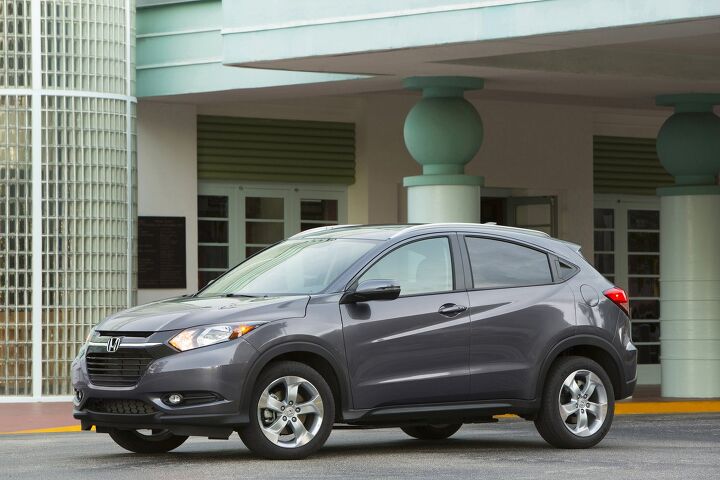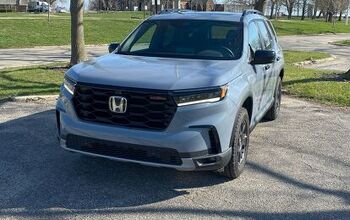Honda HR-V Outsells Fit By Four-To-One, But Why?
During the first three months of Honda HR-V availability, U.S. sales of the Honda Fit jumped 25 percent.
Yet as the public’s HR-V awareness increased – and sales of the Fit-based subcompact CUV decreased due to supply constraints – Fit sales fell through the floor in August and September of 2015. August sales of the Fit were cut in half; September Fit volume plunged 81 percent, falling 5,349 units from what was a 41-month high in September 2014 to only 1,279 sales in September 2015.
U.S. HR-V sales in September were nearly four times stronger than Fit sales, an astonishing figure for a number of reasons.
First, the HR-V wasn’t even close to its peak year-to-date output in September. Sales in June, the HR-V’s first full month, were 68-percent higher.
Second, the Fit is still among the newest subcompacts available. Only the Scion iA sedan, which kicked off its U.S. campaign last month, is a fresher design.
Finally, the very concept of the HR-V and its rivals — slight ride height increases, marginal cargo volume advantages, subdued SUV styling cues, available all-wheel-drive — is a new one for most buyers. Yet combined sales of the HR-V and its cohorts jumped 158 percent in September. Even the more established players, nameplates which were on sale at this time a year ago, rose 24 percent last month.
Yet to instantly surmise that Fit sales are falling simply because thousands of potential Fit buyers are opting instead for an HR-V misses a few key points. Yes, the market is clearly, undoubtedly, undeniably moving away from traditional passenger cars to crossovers, as evidenced by the fact that the auto industry may in 2015 report a 15-year high in total volume despite the fact that passenger car sales are down two percent.
In this particular case, however, there other factors at play. The 2015 Fit has been involved in three separate recalls: the first for side curtain airbags, one for ignition coils, and most recently another for continuously variable transmissions. In this age, however, recalls seem to have little effect on consumer demand.
But what demand there is for the Fit, Honda has little capacity to meet. Between the beginning of 2012 and the end of this July, American Honda averaged 4,700 monthly Fit sales. Demand for the car didn’t suddenly disappear, almost completely, because the HR-V arrived, even if that fits the easy narrative.
In fact, as we already mentioned, coinciding with the HR-V’s launch was a significant Fit sales increase, equalling a 3,045-unit year-over-year improvement between May and July.
Then, Fit supply suddenly dried up. Think back to the beginning of September last year and Honda dealers had a 79-day supply of Fits, approximately 11,000 Fits available for sale. One year later, at the beginning of last month, Honda’s U.S. dealers had just a 27-day supply of Fits; only 3,000 units in stock according to Automotive News. Indeed, combined Fit/HR-V inventory last month was lower than total Fit inventory was one year ago.
Honda needs more capacity for the HR-V, which is built at the Fit’s factory in Celaya, Guanajuato, Mexico. Subcompact crossovers can be very profitable vehicles, and demand for subcompact crossovers is rising. Subcompact cars aren’t very profitable vehicles, and demand for subcompact cars is decreasing. Therefore, “It’s nothing more than a case of numbers,” according to American Honda spokesperson Robyn Eagles. “We are producing more HR-Vs than Fits.”
The situation is now made all the more apparent by the move of some MY2016 Fit production to Japan. Add that to the fact that MY2015 Fits are few and far between – Cars.com lists fewer than 800 in their inventory – and the results are, while far from ideal, rather obvious. U.S. Honda Fit sales in September 2015 were down by four-fifths compared with September 2014.
All fingers pointed at the HR-V? Hardly. HR-V pricing begins at $19,995, $685 in excess of the outgoing Civic’s base MSRP; 20-percent higher than the basic Fit’s sticker. If there’s a group of car buyers unwilling to fork out an extra 20 percent of their hard-earned, it’s the 42,000 people who buy or lease a subcompact car each month. Might some have them moved up the ladder to get into an HR-V in September? Sure, but they don’t explain the Fit’s 81 percent decline.
Timothy Cain is the founder of GoodCarBadCar.net, which obsesses over the free and frequent publication of U.S. and Canadian auto sales figures. Follow on Twitter @goodcarbadcar and on Facebook.
More by Timothy Cain
Latest Car Reviews
Read moreLatest Product Reviews
Read moreRecent Comments
- El scotto UH, more parking and a building that was designed for CAT 5 cable at the new place?
- Ajla Maybe drag radials? 🤔
- FreedMike Apparently this car, which doesn't comply to U.S. regs, is in Nogales, Mexico. What could possibly go wrong with this transaction?
- El scotto Under NAFTA II or the USMCA basically the US and Canada do all the designing, planning, and high tech work and high skilled work. Mexico does all the medium-skilled work.Your favorite vehicle that has an Assembled in Mexico label may actually cross the border several times. High tech stuff is installed in the US, medium tech stuff gets done in Mexico, then the vehicle goes back across the border for more high tech stuff the back to Mexico for some nuts n bolts stuff.All of the vehicle manufacturers pass parts and vehicles between factories and countries. It's thought out, it's planned, it's coordinated and they all do it.Northern Mexico consists of a few big towns controlled by a few families. Those families already have deals with Texan and American companies that can truck their products back and forth over the border. The Chinese are the last to show up at the party. They're getting the worst land, the worst factories, and the worst employees. All the good stuff and people have been taken care of in the above paragraph.Lastly, the Chinese will have to make their parts in Mexico or the US or Canada. If not, they have to pay tariffs. High tariffs. It's all for one and one for all under the USMCA.Now evil El Scotto is thinking of the fusion of Chinese and Mexican cuisine and some darn good beer.
- FreedMike I care SO deeply!



































Comments
Join the conversation
Ooh... you make so mad I put wrong place!
Cannot reasonably think about sales figures of a vehicle without including non Honda in the comparison. For example, Nissan Versa Note is a hatchback, 4 door, small, low power. Compared to FIT, more available, less cargo room, lower price. Also, NVH are better than Fit and acceptable on long drives. Fortunately, buyers do cross shop and do buy something other than Honda.